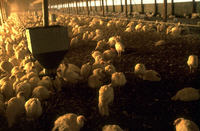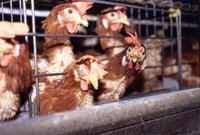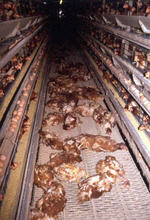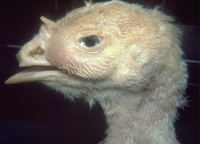



Overview of Avian Influenza
By Dr Dave Halvorson, Extension Animal Scientist, Department of Animal Science, University of Minnesota - Avian influenza (AI) is a viral disease characterized by respiratory signs, depression and reduced feed and water intake. In egg laying birds there is a decline in egg production and quality. There are two pathotypes of AI virus: the most common is low pathogenic AI (LPAI) and the other is highly pathogenic AI (HPAI). |
The most virulent form (HPAI) was once called fowl plague. At the 1981 International Symposium on Avian Influenza, the term fowl plague was replaced with the term "highly virulent" influenza virus infection. The AI epidemic of 1983-1984 required yet new terms to describe relative pathogenicity of different isolates of the same serotype (nonpathogenic, low-pathogenic, highly pathogenic).
Occurrence
AI outbreaks have occurred throughout the world. LPAI is common in large turkey-producing areas, particularly where semi-confinement or range-rearing is still widely practiced. Outbreaks are more sporadic in other areas of the United States. AI can occur in most, if not all, species of birds. In the United States, most outbreaks have been in turkeys. A few outbreaks have occurred in chickens. Humans, horses, pigs, and some wildlife species may be infected with influenza viruses, and a cycle between birds and swine exists.
A chicken outbreak of LPAI in 1983 mutated into HPAI in 1983-1984 resulting in a federal-state eradication program that required the depopulation of 17 million birds. Similar outbreaks of LPAI in Mexico in 1992 and Italy in 1999 also mutated into HPAI causing severe losses.
Historical Information
 Turkey flock with avian influenza. |
It was in 1964 that influenza viruses of low to moderate pathogenicity were first detected in poultry and they have been detected somewhere in United States poultry every year since 1964. History of AI in Minnesota
An International Commission for Control of Avian Influenza monitors outbreaks of HPAI and has designated certain laboratories as reference labs for diagnosis. In the United States, the National Veterinary Service Laboratory in Ames, Iowa, can identify influenza virus serotypes and pathotypes.
Etiogenesis
 HPAI - layers. Ilaria Capua photo. |
Influenza viruses have two important surface antigens, hemagglutinin and neuraminidase, that give rise to subtype names for specific viruses (eg. H4N6). There are 15 hemagglutinins and 9 neuraminidases making for a large number of possible virus subtypes. Influenza viruses are subtyped by hemagglutination inhibition and neuraminidase inhibition tests. Cross-protection does not occur between subtypes.
Influenza viruses vary widely in pathogenicity and ability to spread among birds. Two pathotypes are recognized: LPAI and HPAI. These pathotype designations are derived from laboratory inoculation of 8 susceptible chickens; LPAI isolates cause death in 0 to 5 of 8 chickens and HPAI isolates cause death in 6 or more. Although most H5 and H7 isolates are low path viruses, so far all HPAI outbreaks have been due to H5 or H7 viruses.
All influenza viruses hemagglutinate chicken red blood cells. Most grow readily in embryonating chicken eggs and tissue culture. They are susceptible to detergents, disinfectants and heat.
Epizootiology
Waterfowl and shorebirds (wild and domesticated) are the major natural reservoir of influenza viruses. Wild waterfowl are asymptomatic, may excrete virus in the feces for long periods, may be infected with more than one subtype, and often do not develop a detectable antibody response. Influenza virus has been recovered directly from lake and pond water utilized by infected wild ducks. Contact of these birds with range-reared commercial flocks is an important factor in some outbreaks. This source of infection often results in a seasonal incidence in some states.
Two other reservoirs worth mention are live bird markets and commercial swine facilities. Live bird markets have existed in large cities forever, but they are an emerging phenomenon in some areas. They serve as a focal point for gathering and housing many species of birds that are then sold in or around large cities. These facilities are usually neither cleaned nor depopulated. The continuous supply of susceptible poultry in such markets enhances opportunity for viral replication and mutation, and this in turn enhances the opportunity for viruses to be carried back to susceptible poultry flocks. Swine have been known to be infected with swine flu (H1N1) since the 1930s, but recently another subtype (H3N2) has been spreading in swine populations. Transmission of influenza from swine to turkeys has been documented.
AI viruses have been isolated from imported exotic birds. These infected birds are a potential threat to cage birds, wild birds, and poultry.
Although waterfowl shed virus for long periods, most viral shedding from infected poultry stops after seroconversion. Influenza virus is released in respiratory secretions and excretions and droppings of infected birds where it is protected by organic material. The virus is labile in warm conditions, but can survive for months in a cold environment. Influenza virus has been isolated from turkey eggs and semen, but there is no evidence of egg transmission. Improper disposal of infected eggs could potentially expose other susceptible birds, but such transmission has not been observed.
Once AI is introduced into the poultry industry it is transmitted from farm to farm by direct and indirect contact. AI viruses can be transmitted on contaminated shoes, clothing, crates, and other equipment and by movement of birds.
Clinical Signs
 HPAI - layers. Ilaria Capua photo. |
In young growing turkeys the disease may be subclinical or severe, particularly where secondary infection with live pasteurella vaccine, E. coli, or bordetella occurs. Outbreaks in laying turkeys often reduce production markedly and frequently are associated with abnormal eggshell pigmentation and quality.
Morbidity and mortality are highly variable, depending upon the same factors that determine clinical signs noted above.
HPAI is a severe form of influenza usually seen in chickens. Viruses of high pathogenicity may cause fatal infections preceded by few signs. Onset is sudden, the course is short, affected birds are quite ill, and mortality may approach 100%. Signs may relate to the respiratory, enteric, or nervous systems. There may be diarrhea, edema of the head and face, or nervous disorders.
Lesions
 Swollen sinus in a turkey with avian influenza. |
In HPAI infection, gross lesions in poultry species are the most extensive and severe. Fibrinous exudates may be found on the air sacs, oviduct, pericardial sac, or on the peritoneum. Small foci of necrosis may be apparent in the skin, comb, and wattles or in the liver, kidney, spleen, or lungs. Indications of vascular damage often include congestion, edema, and hemorrhages at many sites.
Classical lesions of HPAI in chickens include cyanosis and edema of the head, vesicles and ulceration on the combs, edema of the feet, blotchy red discoloration of the shanks, petechiae in the abdominal fat and various mucosal and serosal surfaces, and necrosis or hemorrhage in the mucosa of the ventriculus and proventriculus.
Diagnosis
History, signs, and lesions may be suggestive of LPAI, but are similar to other diseases. With HPAI, lesions are more useful in a presumptive diagnosis. Confirmation of AI requires laboratory tests including serology and virus detection. Confirmation of HPAI requires pathotyping the virus.
Influenza virus usually can be isolated in chick embryos from tissue or swab samples of trachea, lung, air sac, sinus exudate, or cloaca. The virus hemagglutinates chicken red blood cells. An agar-gel precipitation test can be used to identify type A internal antigen of the virus or to demonstrate an increase in antibody titer between acute and convalescent sera.
Influenza must be differentiated from other poultry diseases including Newcastle disease, other paramyxovirus infections, mycoplasmosis, chlamydial infections, and fowl cholera. Highly pathogenic AI should be differentiated from velogenic viscerotropic Newcastle disease. Because AI viruses causing highly pathogenic AI are considered exotic to the United States, they are reportable to the USDA, and confirmation by virus isolation is essential.
Control
Minnesota Cooperative Control Program :
Prevention of LPAI is largely through prevention of exposure to influenza viruses by direct or indirect contact with waterfowl and shorebirds, live bird markets and swine farms. Once LPAI is introduced into the poultry industry, control is largely dependent on voluntary efforts since there are no official state eradication programs.
Routine serologic monitoring of blood or egg yolk antibody is used in areas where AI has been a problem. This effort provides early detection of an outbreak and permits other measures such as isolation and sanitation to be used early.
Reporting outbreaks to industry personnel who are in direct or indirect contact with poultry is necessary so that people can take appropriate measures.
Voluntary isolation of infected flocks is the responsibility of the owner and is necessary to prevent transmission to other flocks. (Often doing nothing is the single most important thing to reduce the spread of disease.) Rigorous measures to prevent the contamination of and control the movement of people and equipment are required in order to stop this disease.
Different states and industries take different approaches to the next step. Controlled marketing of flocks after they have recovered from infection is common in the turkey industry. In some broiler producing states, voluntary destruction of infected flocks is encouraged.
Rescheduling flocks is necessary to make sure there is no active AI virus on the farm before another flock is placed.
Vaccines - The Control of Influenza: The Role of Vaccines
Immunity is hemagglutinin subtype specific. Because birds are susceptible to all 15 hemagglutinins preventive vaccination is not practical. Once an outbreak occurs and the subtype is identified, however, vaccination is a tool that may be used to help bring the infection under control. Influenza viruses are unstable so no live vaccines have been developed for poultry. Only killed, injectable vaccines are available and currently USDA prohibits use of H5 or H7 vaccines.
History has proven that prevention of HPAI is based on successful control of H5 or H7 LPAI.
The Economics of Avian Influenza Control
Current USDA quarantine measures reduce the possibility of introducing highly pathogenic influenza through importation of poultry or exotic birds.
All outbreaks of influenza should be reported immediately to the state veterinarian or other appropriate health authorities.
Treatment
There is no effective treatment. However, good husbandry, proper nutrition, and broad-spectrum antibiotics may reduce losses from secondary infections.
Zoonotic Potential
Although infection of humans with AI virus is rare, in 1997 18 people in Hong Kong fell ill due to a HPAI H5N1 virus. Six people died. Eradication of the HPAI outbreak was successful and no further human infection occurred.
In 2003 highly pathogenic avian influenza H7N7 affected over 80 workers and caused the death of one. H7N7 Netherlands
More recently, HPAI has been found in eight East Asia countries where it has been associated with human deaths. Further information available from the CDC.
Source: University of Minnesota Extension Service - May 2005









